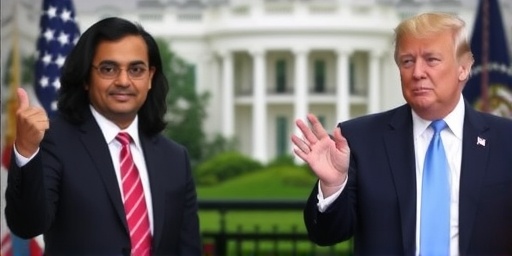In a stunning turn of events that has Washington and New York buzzing, New York City Mayor-elect Zohran Mamdani stepped into the White House today for his first meeting with President Donald Trump, where the two leaders discovered unexpected common ground on pressing urban issues like housing affordability and public safety. The sit-down, held in the Oval Office, lasted over two hours and ended with handshakes and promises of collaboration, defying the deep political divides that have long characterized their respective parties.
- Mamdani’s Rise from Activist to Mayor-Elect Shakes Up NYC Politics
- Trump’s Return to the Presidency Spotlights Urban Renewal Agenda
- Affordability Crisis in New York City Sparks Unlikely Federal Dialogue
- Public Safety Reforms Unite Leaders Amid Rising Urban Tensions
- Political Ripples and Future Collaborations Signal Bipartisan Momentum
Mamdani’s Rise from Activist to Mayor-Elect Shakes Up NYC Politics
Zohran Mamdani, a 32-year-old democratic socialist and state assemblyman from Queens, has been on a meteoric rise since entering politics in 2020. Born in Uganda to Indian parents and raised in New York City, Mamdani’s campaign for mayor focused on progressive ideals: universal healthcare, rent control, and police reform. His victory in the November election, defeating a field of establishment Democrats, was hailed as a seismic shift for the nation’s largest city, with turnout reaching 65%—the highest in decades for a mayoral race.
But today’s White House visit marks a pivot. Sources close to Mamdani say the meeting was initiated by the mayor-elect himself, seeking federal support for New York City’s $112 billion budget, which faces a $7.5 billion shortfall due to post-pandemic recovery challenges. ‘New Yorkers elected me to deliver results, not play partisan games,’ Mamdani told reporters outside the White House gates. ‘If that means sitting down with President Trump to fix our streets and homes, that’s what I’ll do.’
Mamdani’s background adds layers to this narrative. As a member of the Democratic Socialists of America, he has clashed with moderates on issues like defunding the police. Yet, in recent months, he’s moderated his tone on public safety, citing a 15% spike in subway crimes reported by the NYPD in 2023. This evolution, insiders say, paved the way for today’s bipartisan outreach.
Trump’s Return to the Presidency Spotlights Urban Renewal Agenda
President Donald Trump, back in the White House after his 2024 reelection victory, has wasted no time outlining a bold agenda for America’s cities. Drawing from his first term’s infrastructure push, Trump has proposed a $2 trillion national investment plan, with a chunk earmarked for urban revitalization. ‘Cities like New York are the heart of our economy, but they’re bleeding out from bad policies,’ Trump declared in his inaugural address. His administration’s early moves include tax incentives for developers and federal grants for law enforcement tech.
The president’s interest in New York City is personal and political. Having built his brand in Manhattan’s real estate scene, Trump has long viewed the city as a proving ground for his ideas. During the meeting, Trump reportedly reminisced about his days negotiating deals in Midtown, contrasting them with what he called the ‘socialist experiment’ under outgoing Mayor Eric Adams. Yet, the tone was conciliatory. A White House readout described the discussion as ‘productive and forward-looking,’ emphasizing Trump’s willingness to work across the aisle.
Trump’s team highlighted data to underscore urgency: New York City’s homelessness rate has climbed to 90,000 individuals nightly, per HUD estimates, while violent crime in certain boroughs rose 12% last year. ‘We’re not here to point fingers; we’re here to build,’ Trump said in a post-meeting statement, flanked by aides. This rhetoric signals a strategic shift, as Trump courts moderate voters in blue states ahead of midterm battles.
Affordability Crisis in New York City Sparks Unlikely Federal Dialogue
At the core of the Mamdani-Trump meeting was New York City’s affordability crisis, a powder keg that’s driven residents to flee at rates unseen since the 1970s. Median rent for a one-bedroom apartment now averages $3,200, up 25% since 2020, according to Zillow data. Homeownership feels like a pipe dream for millennials, with the city’s poverty rate hovering at 17.3%—affecting over 1.4 million people.
Mamdani, whose platform promised to cap rents at 80% of median income, found an surprising ally in Trump, who touted his past support for Opportunity Zones that funneled $75 billion into low-income areas during his first term. ‘President Trump understands that skyrocketing costs are killing the American Dream, especially in places like New York City,’ Mamdani said. The duo discussed expanding federal low-income housing tax credits, potentially unlocking $10 billion for NYC projects over the next five years.
Experts were quick to note the irony. Dr. Elena Vargas, an urban policy professor at Columbia University, remarked, ‘This bipartisanship on affordability could be a game-changer. Mamdani’s grassroots approach paired with Trump’s deal-making prowess might actually deliver affordable units.’ Quotes from the meeting leaked to the press reveal Trump’s quip: ‘Zohran, you’re a tough negotiator—reminds me of myself back in the day.’ The exchange highlighted a rare moment of rapport, with both leaders agreeing to form a joint task force on housing incentives.
Statistics paint a dire picture: The NYC Housing Authority manages 175,000 units but faces a $40 billion repair backlog. Mamdani pushed for federal emergency funding, while Trump countered with public-private partnerships, citing successful models from his Atlantic City developments. By meeting’s end, they pledged to pilot a program in Brooklyn’s Crown Heights, targeting 5,000 new affordable units by 2026.
Public Safety Reforms Unite Leaders Amid Rising Urban Tensions
Public safety emerged as another pillar of agreement, bridging the ideological chasm between Mamdani’s reformist bent and Trump’s law-and-order stance. New York City’s subways, once a symbol of urban grit, have seen a 20% uptick in assaults since 2022, per MTA reports, fueling resident fears and calls for action. Mamdani, who once advocated for reallocating police funds to social services, now endorses ‘smart policing’—community-oriented strategies backed by data analytics.
Trump, fresh off executive orders boosting federal aid to local law enforcement, saw eye-to-eye here. ‘We need cops on the beat, not bureaucrats in boardrooms,’ he stated. The meeting delved into specifics: increasing NYPD funding for body cameras and mental health response teams, with Trump offering $500 million in Justice Department grants. Mamdani reciprocated by supporting Trump’s national ‘Safe Streets Initiative,’ which aims to deploy AI surveillance in high-crime zones.
Stakeholders reacted with cautious optimism. NYPD Commissioner Jessica Tisch praised the dialogue: ‘This isn’t about left or right; it’s about keeping New Yorkers safe.’ Community advocates, however, urged vigilance. Rev. Al Sharpton, a longtime civil rights leader, tweeted, ‘Bipartisanship is welcome, but it must include accountability to prevent over-policing in Black and brown neighborhoods.’
The discussion also touched on gun violence, with NYC’s 2023 tally of 1,400 shootings drawing parallels to national trends. Both leaders committed to streamlining federal background checks while expanding job training programs to address root causes— a nod to Mamdani’s equity focus and Trump’s economic nationalism.
Political Ripples and Future Collaborations Signal Bipartisan Momentum
As news of the White House meeting spread, reactions poured in from across the spectrum, underscoring its potential to reshape national discourse. Democratic leaders in Congress, wary of Trump’s overtures, nonetheless acknowledged the pragmatic angle. Senate Majority Leader Chuck Schumer, a fellow New Yorker, said, ‘If this brings resources to our city, I’m all for it—bipartisanship works when it delivers.’
Republicans, sensing an opportunity to peel off urban voters, amplified the story. House Speaker Mike Johnson called it ‘a model for the Trump era,’ predicting similar summits with other blue-city mayors. Polling from Quinnipiac shows 58% of New Yorkers approve of the meeting, a boost for Mamdani as he prepares for his January inauguration.
Looking ahead, the implications are profound. The task forces on affordability and safety could influence the upcoming federal budget, with NYC poised to receive unprecedented aid. Mamdani plans follow-up visits to Capitol Hill, while Trump eyes this as leverage for his infrastructure bill. Analysts forecast that successful outcomes might inspire cross-party pacts in cities like Los Angeles and Chicago, fostering a wave of urban bipartisanship.
In the broader context, this encounter challenges the narrative of irreconcilable divides. With New York City’s 8.8 million residents at stake, the Mamdani-Trump alliance could redefine how Washington engages with America’s urban cores. As Mamdani departed the White House, he waved to the press, encapsulating the moment: ‘Today, we proved politics can be about people, not parties.’ The path forward promises collaboration, innovation, and perhaps, a more united front against the challenges facing New York City and the nation.









